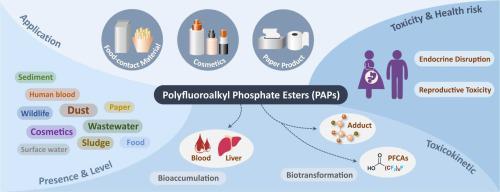Journal of Hazardous Materials ( IF 12.2 ) Pub Date : 2023-11-17 , DOI: 10.1016/j.jhazmat.2023.133018 Junjie Ao 1 , Weifeng Tang 1 , Xiaoning Liu 1 , Yan Ao 1 , Qianlong Zhang 1 , Jun Zhang 1

|
Polyfluoroalkyl phosphate esters (PAPs) are emerging substitutes for legacy per- and polyfluoroalkyl substances (PFAS), which are widely applied in consumer products and closely related to people’s daily lives. Increasing concern has been raised about the safety of PAPs due to their metabolism into perfluorooctanoic acid (PFOA) and other perfluorinated carboxylates (PFCAs) in vivo. This review summarizes the current knowledge on PAPs and highlights the knowledge gaps. PAPs dominated the PFAS profiles in wastewater, sludge, household dust, food-contact materials, paper products, paints, and cosmetics. They exhibit biomagnification due to their higher levels in top predators. PAPs have been detected in human blood worldwide, with the highest mean levels being found in the United States (1.9 ng/mL) and China (0.4 ng/mL). 6:2 diPAP is the predominant PAP among all identified matrices, followed by 8:2 diPAP. Toxicokinetic studies suggest that after entering the body, most PAPs undergo biotransformation, generating phase Ⅰ (i.e., PFCAs), phase II, and intermediate products with toxicity to be verified. Several epidemiological and toxicological studies have reported the antiandrogenic effect, estrogenic effect, thyroid disruption, oxidative damage, and reproductive toxicity of PAPs. More research is urgently needed on the source and fate of PAPs, human exposure pathways, toxicity other than reproductive and endocrine systems, toxic effects of metabolites, and mixed exposure effects.


















































 京公网安备 11010802027423号
京公网安备 11010802027423号